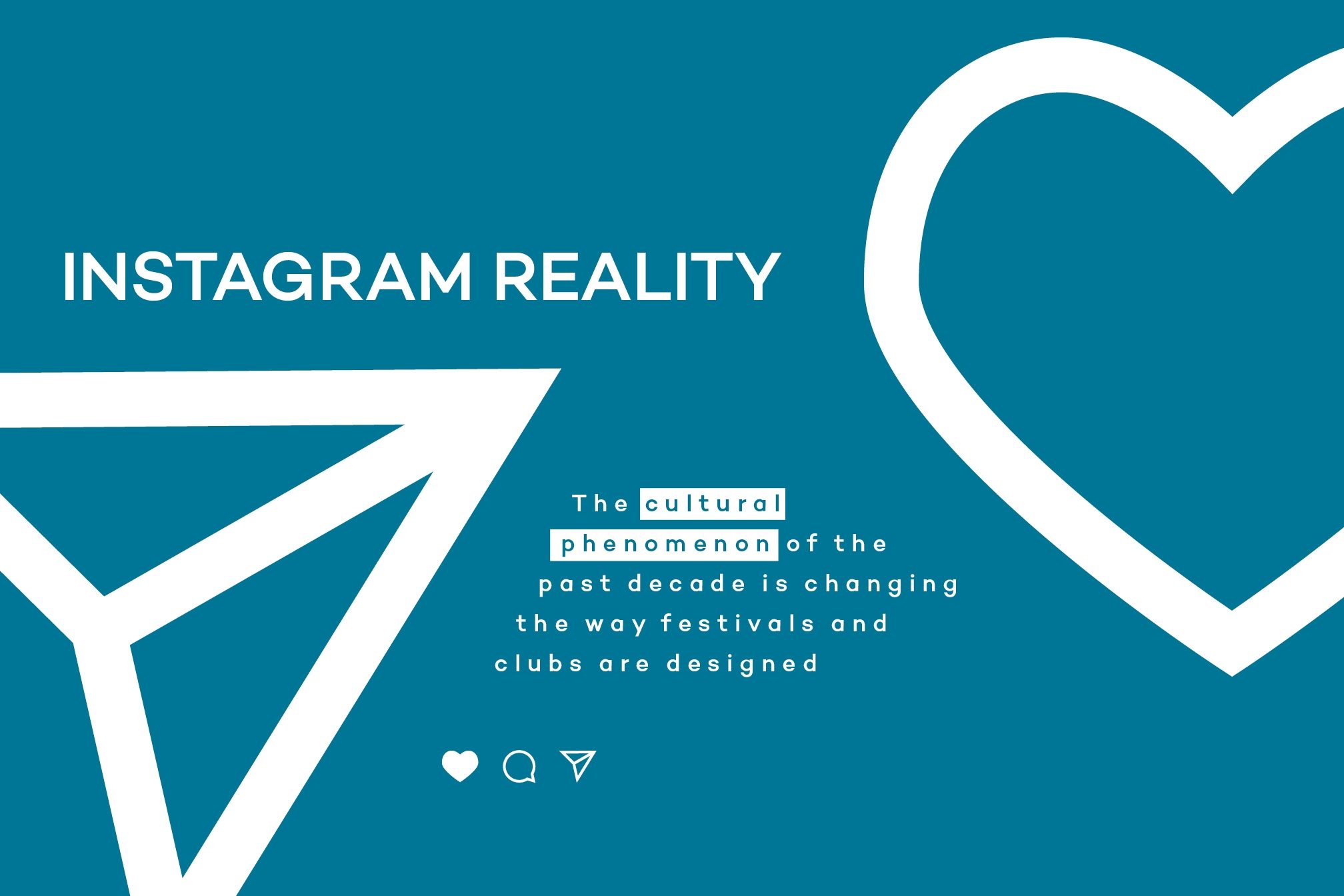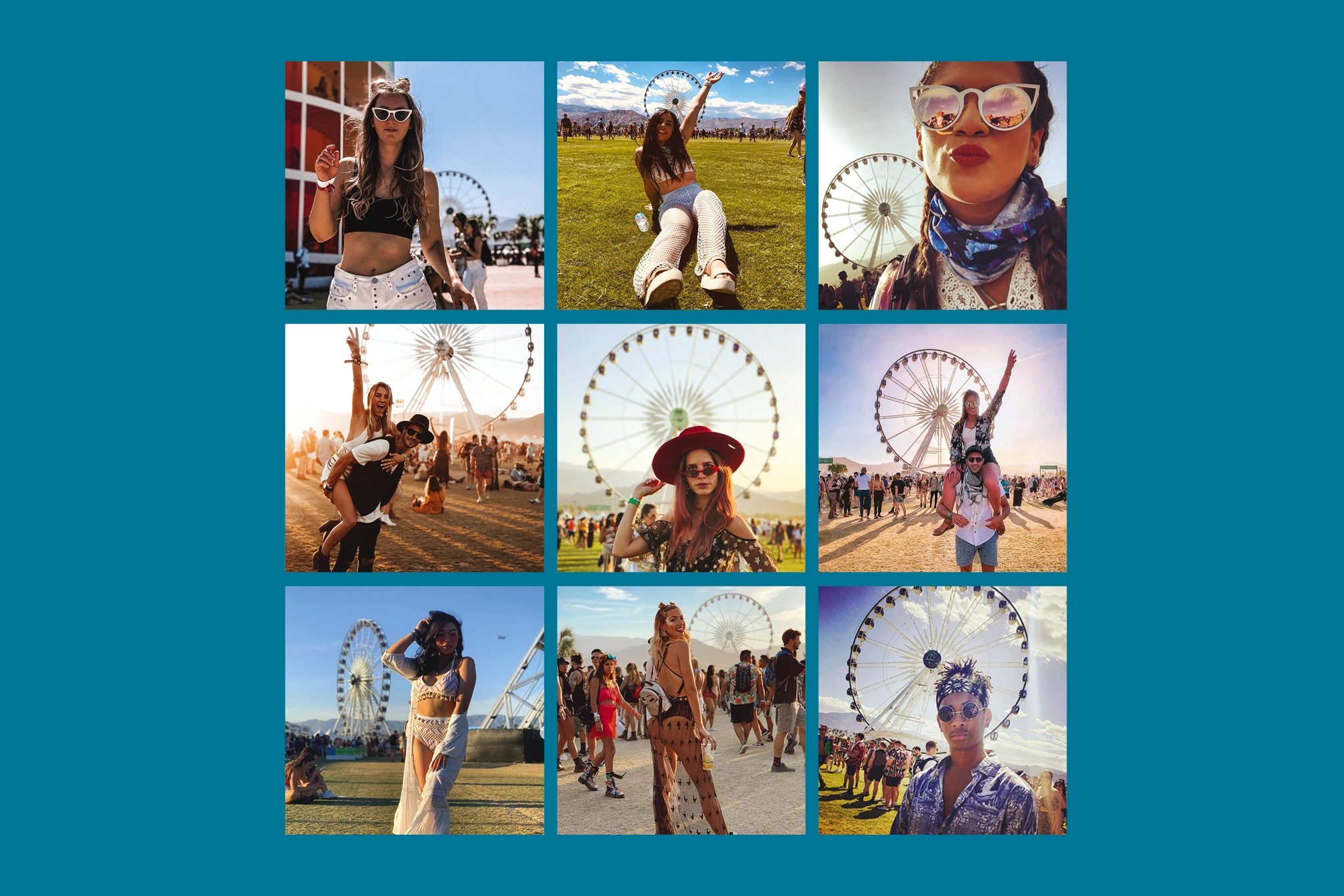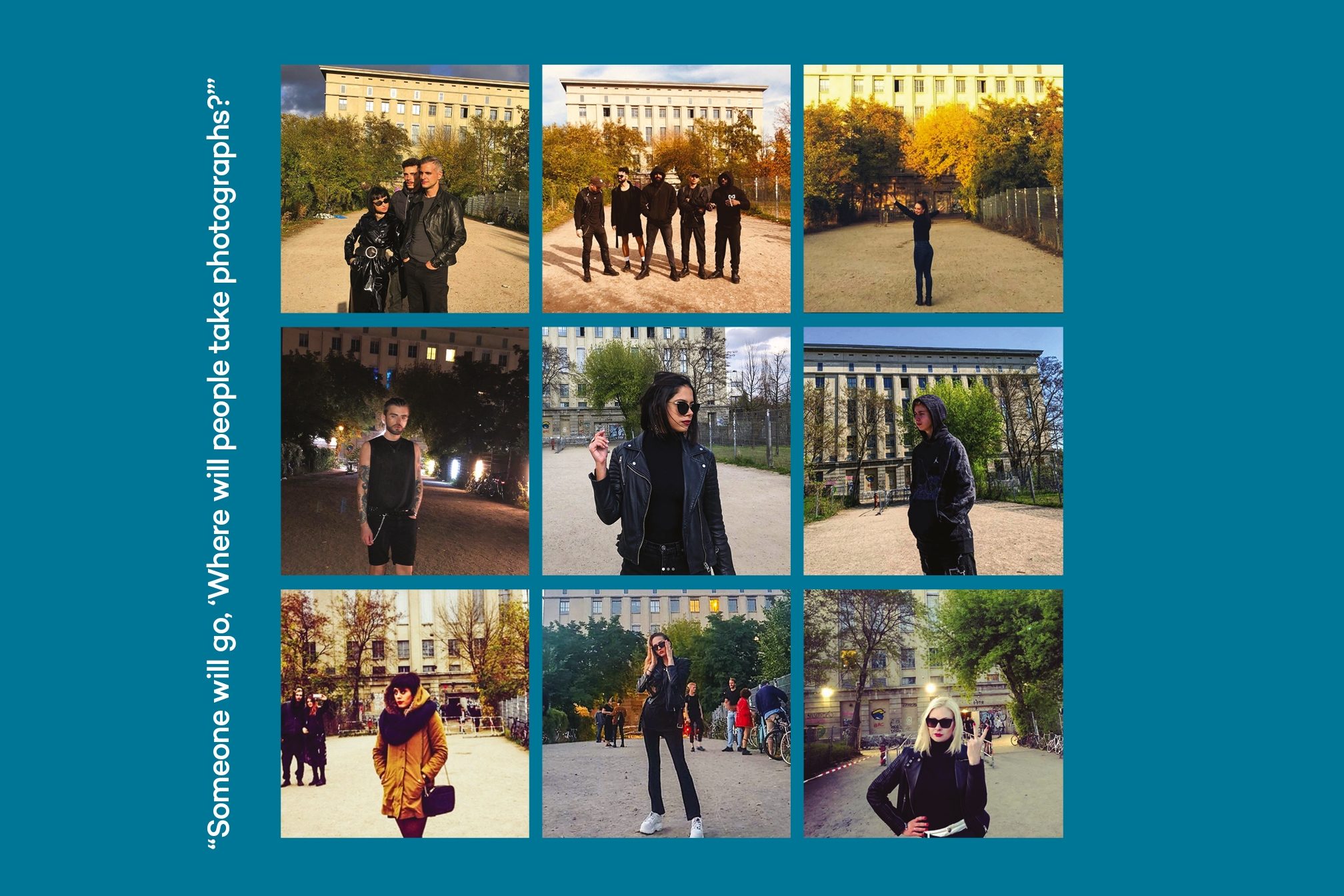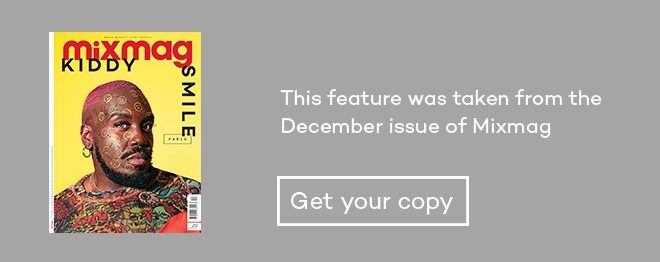 Culture
Culture
How Instagram is changing the design of clubs and festivals
Now is the summer of our disco content
We’re weaving our way through a dusty field. There are palm trees on the horizon, low-slung tents to the right, and the space age arch of a huge dome to our left. At one point a Ferris wheel fills the sky. Crowded with 20-somethings in cut-offs or leggings or vintage-style dresses and sunglasses, this is clearly a main thoroughfare. But not everyone is on the way somewhere. We see first one, then two, then three people standing as if frozen to the spot by a rave gorgon, one foot in front of the other, hand on hip and head cocked to one side, a friend with a phone kneeling or crouching a few feet in front of them like some kind of penitent. We pass another of these tableaux, then another; yet more pairs crowded over a phone to check angles and lighting. The 26-second clip is from Reddit, the post is by u/mandysux, and its title is ‘Coachella, the content farm’. The name of the subreddit is ‘Instagram reality’ and we are living in it. Not so much the winter of our discontent; more the summer of our disco content.
Read this next: Work camera flash: How instagram has changed DJ culture
“The pack normally knows better”, explains Sille Krukow of the University of Copenhagen, a leading international expert in how environmental design can be used to ‘nudge’ behaviour and psychology. “If you stick with them you are ‘safer’. We take cues and cognitive triggers from the environment and what the people around us are doing, and this is called the ‘bandwagon bias’”. It’s the reason, she explains, that you subconsciously follow the crowd when you step off an airplane, and the reason Netflix tells you what’s most popular with everyone else when your series finishes. It’s why, when you see crowds of people taking a selfie for the ’Gram, you feel the urge to join in. On an individual level, she says, the psychological impulses that Instagram use triggers – from bandwagon bias to the dopamine reward of a ‘like’ to loss aversion (broadly, the psychological term for FOMO) are myriad, not at all surprising to its creators, and the main reason it has become such a huge phenomenon. For some people it can quickly become part of their ‘System 1’ behaviour, the unconscious routines and instincts that guide 90 per cent of our decisions, keeping our resource-intensive brains working efficiently. And the consequences of changing human behaviour aren’t just having to watch where you step when stage-hopping across Coachella. Human beings change their environment according to their needs and desires. The Roman Empire’s need for economic and military dominance built roads that brought Europe and parts of Asia and Africa together as never before, made the world smaller and more navigable and irrevocably altered the nature of civilisation. At its peak, the Empire contained about 70 million souls. There are 1 billion regular users of Instagram, 71 per cent of them under the age of 35, the prime age for going to festivals and clubs. So are the Instagram legions changing those environments too?

In terms of growth, the biggest clubbing success story of the past decade is Elrow. Once just an eccentric family-run club in the dusty countryside outside of Barcelona, it’s now a world-straddling megabrand with residencies from Ibiza to Vegas, and events from Jakarta to Manchester, with an average attendee age of 23. Arguably, the main reason for this exponential success is the way that Elrow has harnessed the power of social media to spread the word about – and more importantly the pictures of –their multicolour spectaculars. Marketers call it ‘peer-to-peer’: turning your customers into your salespeople. David Jordan is the Chief Revenue Officer of Elrow (“I’m in charge of everything that brings revenue in, but mainly I’m in charge of marketing.”) Jordan’s background is in online advertising, and he is keenly aware of how important Instagram is to Elrow’s success. “In the last five, six, seven months it has become crucial. Ninety per cent of our ticket sales are online, and all our branding and investment goes online. And on top of what we do on our own channels, Instagram today is where users are sharing Elrow.” Elrow, says David, is able to calculate how much this user-generated marketing is worth, and he puts the average at somewhere around 100,000 Euros per show. Unsurprisingly, this means that “when we prepare a new event or a new animation or activation, the first thing we think about is how it’s going to look on users’ Instagram.”
Read this next: Elrow is the Club Of The Year
Elrow – an early adopter of setting up areas with mirrors or games that work as selfie props – is refining its strategy to bring on board Instagram influencers as ambassadors. But it’s long mastered the art of integrating Instagram into the experience in a way that’s organic, effective and feels as natural as dancing. One vivid example is the paint used for its epic, underwater-themed ‘Rowmudas’ main stage. “In a picture, the texture looks wet, it looks amazing, like it’s coming from the sea,” explains Jordan. Indeed, his designers have not just created an environment that’s Instagram-friendly, they’ve created a sort of augmented reality. “You can’t really see this texture in real life, only in a photograph,” he marvels. Of course, no club’s success is built purely on looking good in pictures. Elrow’s USP, aside from its music, is the narrative created around each night, structured around what Jordan calls ‘animations’ featuring costumed performers interacting with the crowds at set times, often in sync with the DJ’s set or changes to the stage in order to build even more story. “In the middle of a DJ set you could have a moment where a character opens a door ‘to another dimension’ and a lot of characters, like from science fiction movies in the eighties, go to the dancefloor and everywhere: not on stage, but in the middle of everyone.” These moments work as handy cues to focus sharable, hyper-photogenic moments for the crowd, with the performers encouraging just that. The genius of Elrow is turning something that could be passive (taking a picture) into something interactive and immersive; focusing it via narrative onto specific moments also helps to maintain immersion the rest of the night. “The animations mean you don’t just have people going on Safari with their phones all night,” as Jordan puts it.
As Creative Director of the Vibration group, Simeon Aldred has overseen the design of two of the most important new cultural spaces in Europe in the past decade: Printworks and The Warehouse Project’s new home, Depot (as well as the massive ‘Exhibition’ and ‘Magazine’, opened this year in London). His background in festival design means he visualises his events in these ‘found’ (reclaimed/converted) industrial spaces as ‘indoor festivals’ first and foremost – and has enabled him both to respond to and shape the changes in the UK’s clubbing behaviour. “Currently,” he says, “the sound is absolutely the first thing we think about. But I definitely recognise that we do think about [visual] ‘touch points’ through the venue. Even if it’s as simple as light boxes that say ‘drinks’ and a giant Printworks light box. We all know that the girls and boys are gonna stand in front of it and do that thing where they kneel down and do the group shot”.” Different nights and audiences, though, have different priorities, and Aldred wonders whether audiences for The Hydra – the external promoters who run Printworks’ flagship underground night, booking acts like Jeff Mills and Helena Hauff – give a damn about a photograph. “Probably not. The Hydra audience would just be interested in the music and the DJ and the sound.” But Instagram absolutely affects the design of his spaces – if not initially, then as they evolve: “It’s not a priority for us, but more and more in my conversations someone will go, ‘Where will the audience take photographs?’” he says.
Read this next: 20 photos proving Printworks is still London's most jaw-dropping venue
The nature of social media means that Aldred and his team are able to track in real time which areas of the space have become hotspots, something he clearly finds both fascinating and instructive. “As you first go into Printworks there’s a giant sign that did create a bottleneck [for pictures] so we’ve moved that to an area where people can use that backdrop. We’re very aware there are probably eight or nine [similar spots] in Printworks: for instance, when people first go in; the money shot of all the motors; in the courtyard we have big signage that says ‘Printworks’; and we’re seeing more groups standing in the black corridor outside as you first come in. But if I’m honest, these spots are kind of ‘adopted by the people’, if you know what I mean: things we just thought were nice decor pieces are now being adopted as little icons of Printworks. [But] I guess now we know what they’re becoming we probably are amplifying them a bit by giving the things people have adopted more space, moving barriers away from them.”
With Depot, which opened this year in a converted train factory, Aldred’s team were able to apply what they had learned to a found space converted from scratch. “The big learning from Printworks was that where there’s a massive room we’ve kept the room massive. That sounds basic, but the temptation with these spaces is to leverage them, to chop them up into rooms one, two, three – but you end up ruining the reason you took the space. I wanted that arrival to feel massive, to make sure that everyone gets that experience, that epic ‘Wow’, the total immersive sound – but then obviously acknowledging the fact that everyone is going to get their phone up immediately.” Aldred is looking forward to other Instagram ‘touch points’ emerging: “at Depot there’s a giant set of original yellow doors which I suspect will become icons. Once we know what people want to share I guess we will make it easier for people to share them.”

There’s one word that sums up Elrow, or Printworks; that describes spaces like Gashouder in Amsterdam full to the brim for Awakenings, as well as the expectations of people who are clubbing less frequently, who are often basing their decisions on party brands they trust rather than a particular DJ, and are paying more for tickets, all trends that are self evident in nightlife in 2019. The word is ‘epic’. People want to come and they want to be absolutely shocked,” says Simeon. “Our lighting budget at Printworks on one night would do lighting for a whole year at smaller clubs. But I understand that when you’ve got five thousand people paying twenty or thirty pounds a ticket, they want a show.” And, it goes without saying, they want to share the experience. It would be simplistic to put Instagram forward as a reason that ‘ravebox’ clubs, built on the traditional model of sensory deprivation rather than epic visual spectacle, have been in decline for the last decade, while – in the UK for example – epic, ‘tabula rasa’-style venues like Printworks and The Warehouse Project attract huge numbers. Not when there are factors like greedy developers, rising overheads and other changing habits to take into account. But when the ‘traditional’ club space, all sensory deprivation and communal experience, doesn’t fit the needs of much of the audience, it’s almost certainly a factor.
Instagram has changed the club environment both in terms of design and by amplifying broader trends, but it’s in daylight that the changes its legions have wrought are most visible. Josh Flemming is Head of Design and Production at DoLab. Since 2005, when they first started putting on small festivals in the US, they’ve launched the likes of Lightning In A Bottle and co-run the Dirtybird Campout. Most recently, the company launched their own DoLab branded stage at longtime collaborators Coachella. While he maintains that the Instagrammability of his team’s work is a natural consequence of creating something striking and enjoyable, he knows that visual impact is more of a priority than ever: “Festival promoters are realising that it’s not enough any more just to set up a square stage with a bunch of TV screens on it,” he says. Massed LED screens, indeed, were a key driver of the EDM festival boom in the US, bridging the gap between the dynamism of a traditional band show and the static nature of DJing (heart signs and Jesus poses aside), reflecting back the crowd’s energy, magnifying the DJ into superstardom or hypnotising the masses with synced visuals. They are also, in the new Instagram reality, becoming increasingly passé, explain Wonderworks’ Piers Shephard and Rebekah Hanbury. Wonderworks is among the world’s leading event designers, its work on everything from the Olympics opening ceremonies to Tomorrowland to Secret Cinema and the Beyoncé and Jay-Z tour responsible for introducing countless trends, from inflatables to synchronised drones to light-up audience wristbands to heat-sealed mobile phone baggies. Shephard and Hanbury reckon that its lack of Instagrammability has killed the LED-based stage and correspondingly forced people in their line of work to massively raise their game. “There’s a shift away from boring stages dressed up with LED screens – which don’t require a creative team to commit to an aesthetic – and back to big scenery,” says Piers. Rebekah agrees: “Compare Beyoncé’s 2006 gigs [with a video wall] to her last Coachella gig, with that pyramid of people. It’s a definite push-back.” Wonderworks’ ethos, they explain, is finding new ways to keep the crowd at the events they design ‘dynamic’ – ie moving and interacting – and surprised, both of which are harder to do when they have their phones out, and when anything they see can be posted and shared in a matter of seconds. And this is a challenge that all festivals are facing today.
Read this next: The art of club design
“Festivals are putting a lot more into interactive environments, art and different types of architecture that people can get lost in exploring,” says Tamás Kádár, CEO of Sziget in Budapest. He describes Instagram, both as marketing tool and also generated by users (he estimates the hashtag #Sziget has been used on the app about half a million times) as ‘an essential part of our communication’. Like Aldred, he’s aware that certain areas will become selfie touchpoints – such as the huge Sziget letters that surface like the Hollywood sign from the Danube. ‘We’re not creating areas for Instagram, but we know the areas we create have to be Instagram-friendly,” he says. While he emphasises that the “authentic festival experience” of the island festival’s 50 diverse stages and themed areas is Sziget’s design priority, he agrees that “in the last five to ten years the visual approach and the spectacle of Sziget have become more and more important; the past three years, it’s become essential.” This ties in with the festival’s broader social mission – as well as working with Hungarian design groups each year, the organisers invite international submissions to their ‘Art Of Freedom’ competition, asking designers and artists to submit ideas for installations, arenas and environments which Sziget finances.
Both Flemming and Kádár agree that the major change in festival culture that Instagram has driven in the past five years is the increasing synthesis of artwork with festival culture. “There was a time,” says Josh, “when it was just music festivals; then it was ‘music and art’ festivals, and now it’s ‘art and music festivals’.
One such is Thailand’s Wonderfruit, a visually stunning pop-up city of a festival in Chon Buri province that aims to ‘create a dialogue using art and culture’ with a strong ethos of sustainability, showcasing local visual artists via a dedicated art curator, close ties to the global art world, and, like Sziget, a yearly competition to design a sustainability pavillion. Form follows function at Wonderfruit, says founder Pranitan ‘Pete’ Phornprapha: “We’re not like, ‘Oh, how can we make this a photogenic thing’ – we don’t think like that. But with the way we try to design, it becomes a photo opportunity, naturally.” Wonderfruit, says Pete, built its name through word of mouth (it’s now in its sixth year), but perhaps it’s worth asking whether boutique, arts-based, visually unique festivals would be such a feature of the landscape at all in 2019 were it not for Instagram. “When the time comes with the festival,” says Pete, “we see an explosion of images that go viral throughout the world.” Instagram in the festival space drives the thirst for visual novelty and creativity: not just people looking for content to post, but also in order for festival marketing to stand out, to own a unique aesthetic. In turn, the boom in synthesizing visual art installations and artworks into the festival (and also increasingly the club) space is one of the clearest examples of how the app affects the rave environment.

But while it seems a truism that any movement to get art in front of more people and create new outlets for artists is A Good Thing, not everyone agrees. Wolfgang Tillmans, Turner Prize-winning artist, techno producer, Panorama Bar regular and Mixmag reader, isn’t sure that the club space in particular is the right forum. “To me, since the early days of techno the music is the art, then come the lights and the venue and, of course, the revellers. When these elements are in tune and pushing the limits, I honestly don’t miss anything, and I find a film or other art narratives distracting. The installation is the club, the speakers are the sculpture, the bodies and the faces are the film.”
Read this next: Wolfgang Tillmans took Frank Ocean to Berghain
Perhaps, though, we shouldn’t be too worried that we are somehow losing the ‘traditional’ club environment to Instagram users with their pesky phones and rewired brains. What is the traditional club environment, anyway? Here’s Joey Llanos, talking to Time Out about his former workplace. “Michael Brody owned a house in The Pines on Fire Island. So he designed the roof [of the club] as if you were in the Pines on Fire Island, with all the decking. There was a florist on staff, and we’d always have birds. Michael would pay for beautiful art pieces to be displayed.” The year was 1978. Llanos was head of security at Brody’s nightclub, a little place called The Paradise Garage.
For Simeon Aldred, seeing what people at Printworks enjoy via what they post is not only a source of inspiration, but also recognition for his team’s hard work. “When we first started Printworks, someone suggested that we should ban pictures, like at Berghain. I was like, ‘Definitely not!’ Why would we be spending so much on lighting? Why are we creating this aesthetic? Not only to create an amazing human experience, but to create an experience we expect people to share.”
“The good thing,” says David Jordan, “is to dance and enjoy yourself to the max. But leaving your phone at home? Let’s be realistic. That’s not going to happen.”
Duncan Dick is the Mixmag's Editor, follow him on Twitter
[Photography: travelislovexoxoalli, tamaraaahhh, flutterflypanda, aman.shai.xox, stanbarleystephaniedemner, Merrrica, xkflyaway, missmassblog, reborn_damned, tomtomroyal, 4galletasconleche, alessandro_zingrillo, kicylichka, weronikalenarcxyk, vale_dvnhc, djgriffin, Romina.mazzini/clockworkstudio]
Read this next: Get the best of Mixmag direct to your Facebook DMs



